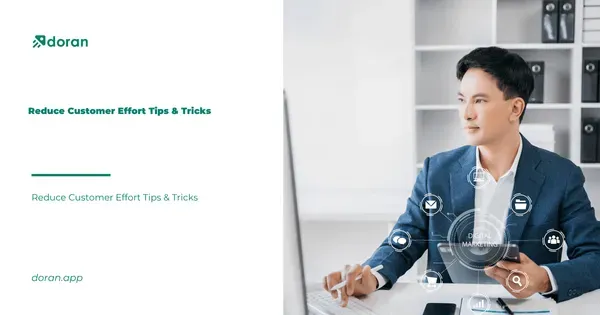Reduce Customer Effort Tips & Tricks
Table of contents 8 min
Reducing customer effort is a key component in enhancing customer satisfaction and loyalty. By minimizing the effort customers need to exert to achieve their goals, businesses can significantly improve the overall customer experience. In this guide, we will explore what customer effort is, how to calculate it, and provide actionable tips and tricks to help you effectively reduce customer effort across various touchpoints.
Customer Effort: What Is It?

Customer effort refers to the amount of work a customer has to do to interact with your business, from finding information to resolving issues or making a purchase. The concept is grounded in the idea that the easier it is for customers to accomplish their goals, the more satisfied they will be with your service. High customer effort often leads to frustration, dissatisfaction, and ultimately, customer churn.
On the other hand, businesses that successfully reduce customer effort create a smoother, more enjoyable experience, fostering customer loyalty and encouraging repeat business. Understanding customer effort is crucial for any company looking to optimize its customer experience strategy.
How to Calculate Customer’s Effort

Measuring customer effort is essential for understanding where improvements are needed. The most common method is through the Customer Effort Score (CES), a survey-based metric that asks customers to rate how much effort they had to put forth to get their issue resolved. However, calculating customer effort can go beyond CES by gathering comprehensive input, learning from departing clients, analyzing the customer journey, and leveraging support data.
Read more: Customer Effort Score (CES): Definition & Ways to Measure
Obtain Input
To accurately calculate customer effort, it’s vital to obtain direct input from customers. Surveys, feedback forms, and direct interviews can provide insights into the specific areas where customers feel they are spending too much effort.
By asking targeted questions about their experiences with your products, services, and support processes, you can gather valuable data that highlights the pain points in the customer journey. This input is the foundation for identifying areas where you need to reduce customer effort.
Take Advice From Leaving Clients
Clients who choose to leave your service can be an invaluable source of information. Exit interviews or surveys can help you understand why they left and what specific challenges led to their decision. Often, high customer effort is a contributing factor to churn.
By learning from these departing customers, you can pinpoint which aspects of your business require attention and take steps to reduce customer effort for future users. Implementing changes based on this feedback can lead to a more streamlined experience, reducing the likelihood of future churn.
Examine the Customer Journey
A thorough examination of the customer journey is critical for identifying where customers may be experiencing unnecessary friction. By mapping out every touchpoint—from initial contact through to post-purchase interactions—you can identify stages that require excessive effort.
Whether it’s a complex checkout process, difficulty finding information, or challenges in contacting support, understanding the entire journey allows you to pinpoint where to reduce customer effort effectively. This examination should be ongoing, as customer needs and expectations evolve over time.
Find out more: NPS and the Customer Journey: Mapping Feedback to Touchpoints
Utilize the Support Data
Support interactions provide a wealth of data that can be used to calculate customer effort. By analyzing the number and nature of support requests, response times, and resolution rates, you can identify trends that indicate high customer effort.
For instance, if customers frequently contact support for the same issue or if resolution times are long, it’s a sign that certain processes are too complicated or unclear. Leveraging this data enables you to make informed decisions on how to reduce customer effort by simplifying processes, providing better resources, or improving support efficiency.
Ways to Reduce Customer Effort

Once you’ve identified areas of high customer effort, the next step is to implement strategies to reduce it. There are several effective approaches you can take to streamline customer interactions and create a more effortless experience.
Make User Journeys That Are Easy to Understand
Creating clear, intuitive user journeys is one of the most effective ways to reduce customer effort. This involves designing your website, app, or service pathways so that customers can easily navigate them without confusion.
Key actions, such as finding information, completing purchases, or accessing support, should be straightforward and require minimal steps. Simplified navigation, well-placed calls to action, and clear labeling all contribute to a user-friendly experience. When customers can achieve their goals quickly and easily, they’re more likely to have a positive experience and return in the future.
At Every Touchpoint, Streamline Interactions
Streamlining interactions at every touchpoint is crucial for reducing the effort customers need to exert. This means ensuring that each stage of the customer journey—from initial inquiries to post-purchase support—is optimized for efficiency and ease.
For example, simplifying forms, reducing the number of clicks required to complete a task, and providing clear, concise information can significantly reduce customer effort.
Additionally, making sure that customer information is readily accessible and doesn’t need to be repeatedly entered at different stages can make the entire process smoother and more enjoyable for the customer.
Make Use of Self-Service Tools
Self-service tools are an excellent way to empower customers and reduce customer effort. By providing resources such as FAQs, knowledge bases, chatbots, and tutorial videos, you enable customers to find answers and resolve issues on their own, without needing to contact support.
Self-service options are particularly valuable for customers who prefer to troubleshoot independently and at their own pace. Moreover, these tools can be available 24/7, offering immediate assistance regardless of time zones or business hours. Ensuring that your self-service resources are comprehensive, easy to use, and regularly updated will enhance their effectiveness in reducing customer effort.
Make Use of Automation
Automation can play a significant role in reducing customer effort by handling repetitive tasks and streamlining processes. For instance, automated responses for common queries, order confirmations, and follow-ups can save customers time and reduce the need for manual intervention.
Additionally, automating processes like billing, renewals, or appointment scheduling minimizes the effort required from customers, allowing them to focus on what’s most important. When properly implemented, automation can lead to faster resolutions, fewer errors, and a more seamless overall experience, all of which contribute to a significant reduction in customer effort.
Make Mobile-Friendly Optimization
In today’s digital landscape, many customers interact with businesses through mobile devices, making mobile-friendly optimization essential for reducing customer effort. A mobile-optimized website or app ensures that customers can easily navigate, shop, or seek support from their smartphones or tablets. This involves responsive design, quick loading times, and intuitive interfaces that adapt to smaller screens.
By prioritizing mobile-friendly optimization, you reduce customer effort by allowing customers to accomplish their goals effortlessly, regardless of the device they’re using. This convenience is crucial for maintaining customer satisfaction and encouraging repeat business.
Make Use of Omnichannel
An omnichannel approach enables customers to interact with your business seamlessly across multiple channels—whether through email, social media, phone, or in-person.
By providing consistent and connected experiences across these channels, you reduce customer effort by allowing customers to choose the method of communication that best suits their needs. For example, a customer who starts a conversation through a website chat should be able to continue it through email without needing to repeat information. An effective omnichannel strategy ensures that customers can transition between channels without friction, leading to a more cohesive and effortless experience.
Address Problems from Initial Contact
Resolving customer issues at the first point of contact is one of the most effective ways to reduce customer effort. First Contact Resolution (FCR) ensures that customers do not have to repeatedly reach out to resolve the same issue, which can be a significant source of frustration. To achieve high FCR, it’s important to equip your customer support team with the necessary tools, training, and authority to address a wide range of issues on the spot. When customers know that their problems will be resolved quickly and efficiently, their overall effort is minimized, leading to greater satisfaction and loyalty.
In conclusion, the effort to reduce customer effort is a crucial element in delivering a superior customer experience. By understanding what customer effort is, accurately calculating it, and implementing strategies to minimize it, businesses can significantly improve customer satisfaction, retention, and loyalty. Focusing on reducing customer effort through clear user journeys, streamlined interactions, self-service tools, automation, mobile optimization, omnichannel experiences, and effective problem resolution from the first contact will not only enhance customer experience but also contribute to long-term business success.
What to not miss out on our blog
Gain insightful knowledge and invaluable experiences from dedicated experts.

How to Optimize Shopify Logo size: An in-depth Guide
Discover how to optimize Shopify logo size. Learn best practices for resizing and recommended dimensions tips to make your logo looks perfect on all devices.


